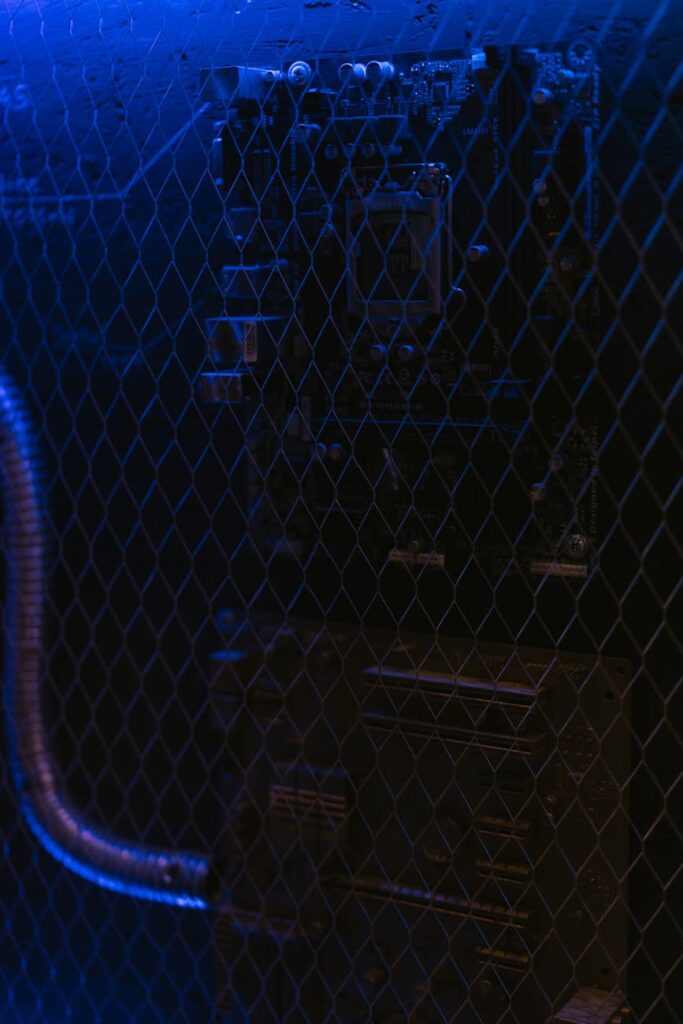The Internet’s Annoying Speed Bump and the Genius Solution You’ve Never Heard Of
Ever been on a crucial video call when your face suddenly freezes into a pixelated nightmare? Or maybe you’ve yelled at a streaming service that decided to buffer at the exact climax of a movie. We’ve all been there. It’s frustrating. That delay, that tiny little pause that feels like an eternity, is called latency. And for a long time, we’ve just accepted it as a part of life online. But what if I told you it doesn’t have to be that way?
Most of us think of the internet as this magical, instant cloud. You click something, and it happens. The reality is a bit more… geographical. When you stream that movie, your request might travel hundreds, even thousands, of miles to a massive data center. The server finds your movie, and then sends it all the way back to your screen. This round trip takes time. Milliseconds, yes, but those milliseconds add up. Now, imagine a world that doesn’t just need to stream movies, but needs to power self-driving cars, run robotic surgeries, and manage entire smart cities in real-time. Those milliseconds suddenly become the difference between a smooth operation and a catastrophic failure. This is the exact problem that a groundbreaking concept is solving. So, if you’re wondering what is edge computing, you’re asking one of the most important questions in technology today. It’s the quiet revolution that’s making our digital world faster, smarter, and more reliable by tackling the problem of distance.
Key Takeaways
- Edge Computing brings the processing power closer to you. Instead of sending data to a distant cloud, it’s analyzed locally, on or near the device that creates it.
- It’s all about speed. By cutting down the travel distance for data, edge computing dramatically reduces latency, enabling real-time applications like autonomous vehicles and augmented reality.
- It’s not a replacement for the cloud. Edge and cloud computing work together. The edge handles immediate, time-sensitive tasks, while the cloud handles heavy-duty processing and long-term storage.
- This technology is crucial for the future. The explosion of IoT devices, from smart watches to industrial sensors, generates too much data for the cloud to handle alone. The edge is the necessary filter.
So, What Is Edge Computing? A No-Nonsense Breakdown
Let’s ditch the jargon for a second. Imagine you’re craving a snack. Your house is a giant data center (the cloud), and the kitchen is where all the food processing happens. If you’re in your upstairs bedroom and want a cookie, you have to walk all the way downstairs to the kitchen, get the cookie, and walk all the way back up. That’s traditional cloud computing. It works, but there’s a delay.
Now, what if you put a mini-fridge with some snacks right in your bedroom? That’s edge computing. You’re not replacing the main kitchen—you still need that for big meals and storing groceries. But for a quick, immediate need, you have processing power (the mini-fridge) right where you are. It’s faster and way more efficient.
In technical terms, edge computing is a distributed computing paradigm that brings computation and data storage closer to the sources of data. Instead of sending raw data from a sensor, a camera, or your phone to a centralized cloud for processing, that processing happens on an ‘edge device.’ This could be the device itself (like your smartphone), or a small local server called an ‘edge gateway’ that sits nearby—maybe at the base of a cell tower or inside a factory.
This simple shift from a centralized to a decentralized model is a complete game-changer. It’s about processing the right data, in the right place, at the right time.

Cloud Computing vs. Edge Computing: It’s Not a Battle, It’s a Partnership
There’s a common misconception that edge computing is here to kill the cloud. That couldn’t be further from the truth. They aren’t rivals; they’re partners in a powerful symbiotic relationship. Thinking of it as an ‘either/or’ situation is missing the point entirely. The cloud is, and will remain, absolutely essential. You just can’t beat it for raw, brute-force computational power and massive, long-term data storage.
Think of it like a company’s structure. The cloud is the corporate headquarters (HQ). It’s where the big, long-term strategic decisions are made, where all the historical data is stored, and where complex, resource-intensive projects are undertaken. Edge devices are the local branch offices. They are on the front lines, making quick decisions based on local conditions and handling day-to-day customer interactions. The branch office doesn’t need to call HQ to approve every single small transaction, that would be incredibly inefficient. Instead, it handles what it can locally and sends summarized reports and important data back to HQ for larger analysis. That’s exactly how edge and cloud work together.
Here’s a simple breakdown of their complementary roles:
- Data Processing Location: Cloud processing happens in large, centralized data centers. Edge processing happens on or near the device generating the data.
- Latency: Cloud has higher latency due to the physical distance data must travel. Edge has ultra-low latency because the distance is minimal.
- Bandwidth Usage: Cloud requires a lot of bandwidth to transfer all raw data. Edge saves bandwidth by processing data locally and only sending essential results to the cloud.
- Best Use Cases: Cloud is ideal for big data analytics, machine learning model training, and long-term data archiving. Edge excels at real-time applications, rapid decision-making, and operating in environments with poor connectivity.
The edge acts as a smart, rapid-response filter for the cloud. It sifts through the mountains of data generated every second and says, “This is important, act on it now!” while telling the rest, “This can be sent to the cloud for later analysis.”
Why Does Edge Computing Suddenly Matter So Much?
Edge computing isn’t a brand-new idea, but its time has finally come. A few massive technological shifts have converged to push it from a niche concept to a mainstream necessity. The primary driver? The absolute explosion of the Internet of Things (IoT). We now have billions of connected devices—from smart watches and security cameras to industrial sensors on a factory floor and agricultural monitors in a field. These devices are generating an unfathomable amount of data, a literal ‘data tsunami’. Trying to send all of that data to the cloud is simply not sustainable. The pipes would get clogged, and the costs would be astronomical.
Couple that with the rollout of 5G networks, which provide the high-speed, low-latency connectivity needed for edge devices to communicate effectively, and you have a perfect storm. Here’s why this matters to you, your business, and the future of technology.
Blazing-Fast Speed and Reduced Latency
We’ve talked about latency, but let’s put it in perspective. For a self-driving car, a 100-millisecond delay in receiving a command from the cloud to brake could be the difference between a safe stop and a serious accident. The car’s sensors need to identify a pedestrian, process that information, and activate the brakes in a fraction of a second. It cannot afford to wait for a round trip to a data center in another state. By processing that critical data right inside the car itself—on the edge—the decision is instantaneous. This is true for countless applications: a surgeon controlling a remote robotic arm needs zero lag, and an augmented reality headset needs to overlay digital information onto your vision without a nauseating delay.
Saving Bandwidth (and Money)
Bandwidth isn’t free. Continuously streaming high-definition video from thousands of security cameras to a central cloud server would be prohibitively expensive. Edge computing offers a much smarter approach. An edge device, perhaps a small server on-site, can analyze the video feeds in real-time. It can be programmed to ignore hours of footage of an empty hallway but instantly send an alert and a short clip to the cloud the moment it detects motion. This simple act of pre-processing at the edge can reduce bandwidth consumption by over 90%, leading to massive cost savings and a more efficient network.
Enhanced Security and Privacy
Sending all your data to a central location creates a single, high-value target for cyberattacks. The more data travels across the internet, the more opportunities there are for it to be intercepted. Edge computing can significantly bolster security by keeping sensitive data local. For example, a hospital can use edge devices to monitor patient vitals. The data can be analyzed right there at the bedside or at a local server on the hospital’s network. Only critical alerts or anonymized data summaries might be sent to the cloud. This minimizes the exposure of sensitive patient health information (PHI) and helps with compliance for regulations like HIPAA. Your smart home speaker processing your command to “turn on the lights” locally, without sending your voice clip to a server, is another great example of privacy by design, enabled by the edge.
Unwavering Reliability, Even Offline
What happens to a ‘smart factory’ when its internet connection goes down? In a purely cloud-based model, everything grinds to a halt. Production stops, and money is lost. In an edge computing model, the factory can continue to operate seamlessly. The local edge servers and devices can manage the assembly lines, monitor for equipment failures, and keep everything running smoothly based on pre-loaded logic and local data. They can store the operational data and then sync it with the cloud once the connection is restored. This resilience is critical for mission-critical applications in manufacturing, energy grids, and transportation.
“The fundamental idea of edge computing is to move the computation away from the centralized cloud and closer to the action. It’s not about replacing the cloud, but augmenting it. The cloud does what it does best—big data and massive computation—and the edge does what it does best—real-time action and immediacy.”

Real-World Examples of Edge Computing in Action
Theory is great, but where is edge computing actually making a difference today? You might be surprised to learn you’re likely already using it. It’s becoming the invisible backbone of modern technology.
The Internet of Things (IoT) and Your Smart Home
Your Amazon Echo or Google Home is a perfect, simple example. When you say, “Hey Google, what’s the weather?” the device uses a keyword spotter that runs locally—on the edge—to recognize its wake word. This is why it can respond instantly even before it queries the cloud for the weather forecast. More advanced smart home hubs process simple commands like turning on a light switch directly, without ever needing to contact an external server, making your home smarter and faster.
Self-Driving Cars: Decisions in Milliseconds
As mentioned before, this is the killer app for edge computing. An autonomous vehicle is essentially a data center on wheels. It’s equipped with dozens of sensors—LIDAR, radar, cameras, GPS—that generate up to a gigabyte of data *per second*. This data must be processed in real-time to navigate, identify obstacles, and make life-or-death decisions. There is absolutely no time to send this data to the cloud and wait for instructions. All the critical processing happens on the car’s powerful onboard computers.
Retail and Manufacturing: The Smart Factory Floor
In a smart factory, edge computing is used for predictive maintenance. Sensors on a piece of machinery can analyze vibration and temperature patterns locally. An edge gateway can run a machine learning model that detects anomalies indicating a potential failure is imminent. It can then automatically schedule maintenance *before* the machine breaks down, preventing costly downtime. In retail, edge computing powers things like Amazon’s Just Walk Out stores, using cameras and sensors to track what you take and charge you automatically, all processed in real-time within the store itself.
Healthcare: The Future of Patient Monitoring
Wearable health monitors, like smartwatches that can perform an ECG or detect a fall, are edge devices. They analyze your biometric data directly on the device. They don’t need to constantly stream your heart rate to the cloud. They only send an alert to a doctor or family member when the onboard algorithm detects an abnormality. This ensures immediate alerts, preserves battery life, and protects patient privacy.
The Challenges and The Incredibly Bright Future
Of course, no technology is a silver bullet. Edge computing comes with its own set of challenges. Managing and updating software on potentially millions of distributed devices is far more complex than managing a centralized data center. Physical security is also a concern—an edge gateway in a remote location is more vulnerable to tampering than a server in a secure data center. These are complex problems that brilliant engineers are working to solve.
But the future is undeniably at the edge. We’re seeing the rise of Edge AI, where machine learning models are deployed directly onto edge devices. This allows for incredibly powerful, real-time intelligence without a cloud connection. Imagine a smart camera that can identify a specific product defect on an assembly line or a medical device that can diagnose conditions from a scan right in a rural clinic. As devices become more powerful and networks get faster, the capabilities of the edge will only continue to expand, weaving themselves ever deeper into the fabric of our daily lives.
Conclusion
So, what is edge computing? At its heart, it’s a simple, powerful idea: let’s stop wasting time and energy shipping data across the world when we can get the job done right here, right now. It’s a fundamental shift that acknowledges the physical reality of our digital world—distance matters. By bringing processing power closer to where data is born, edge computing is unlocking a new generation of applications that are faster, more secure, more reliable, and more efficient than ever before. It’s not just a buzzword; it’s the next logical step in the evolution of the internet, and it’s quietly powering the real-time, intelligent future that was once the stuff of science fiction.



 What is an API? A Simple Guide for Beginners (2024)
What is an API? A Simple Guide for Beginners (2024)  Digital Twin Guide: Building Virtual Replicas of Reality
Digital Twin Guide: Building Virtual Replicas of Reality  Tech’s Impact on Mental Health: A Balancing Act
Tech’s Impact on Mental Health: A Balancing Act  Unhackable Internet: The Promise of Quantum Cryptography
Unhackable Internet: The Promise of Quantum Cryptography  Ethical Hacking: Guardians of the Digital Realm
Ethical Hacking: Guardians of the Digital Realm  Space Exploration’s Future: AI, Robotics & 3D Printing
Space Exploration’s Future: AI, Robotics & 3D Printing  DeFi’s Hurdles: Security, Scalability & Regulation
DeFi’s Hurdles: Security, Scalability & Regulation  How to Read a Crypto Whitepaper: A Beginner’s Guide
How to Read a Crypto Whitepaper: A Beginner’s Guide  Find Undervalued NFT Projects: A Complete Guide
Find Undervalued NFT Projects: A Complete Guide  Blockchain Consensus Mechanisms Explained (PoW vs. PoS)
Blockchain Consensus Mechanisms Explained (PoW vs. PoS)  NFTs & Music: Empowering Artists in the Digital Age
NFTs & Music: Empowering Artists in the Digital Age  Trader’s Psychology: Master Fear & Greed in Markets
Trader’s Psychology: Master Fear & Greed in Markets